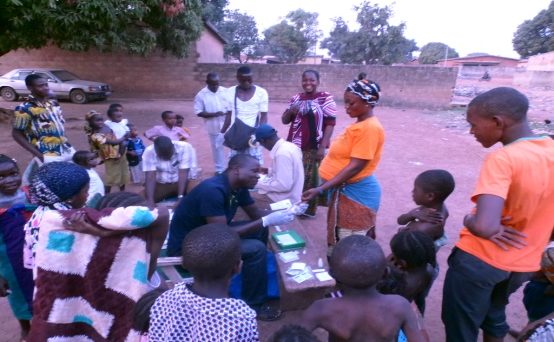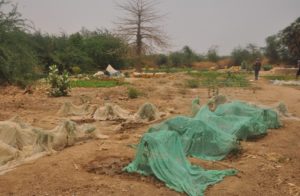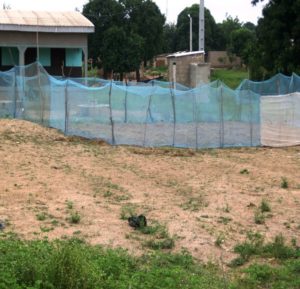
Asymptomatic carriers of Plasmodium spp. (ACPs) are important sources of infections for malaria vectors and thus contribute to the anchoring of the disease in favorable periods. Despite the large proportion of Plasmodium spp infections in asymptomatic carriers in endemic countries, APCs are not yet targeted by national intervention strategies such as in Côte d’Ivoire where malaria is perennial, and hence represent a persistent pool for maintaining the parasite life cycle and transmission by the anopheline vector.
Some authors use ‘’chronic malaria infections’’ to attribute asymptomatic malaria infection (AMI). Commonly, AMI is defined as parasite detection in peripheral thick blood smears without symptoms and non-fever (axillary temperature less than 37.5°C). However, parasite prevalence estimations vary considerably in sensitivity as the quality of microscopy diagnosis in low infections is not satisfying in many Sub-Saharan African settings.
Designing AMI detection surveys
To enhance our understanding of the epidemiology of AMI in urban areas, two cross-sectional studies were carried out in Korhogo (northern Côte d’Ivoire) and Kaedi (southern Mauritania) during 2014 and 2015. During each season, 728 households were randomly selected and a household-based questionnaire was implemented to collect demographic and epidemiological data including the malaria preventive methods used in their communities.
Finger-prick blood samples were obtained for biological examination using microscopy and routine rapid diagnostic tests (RDTs). Thin blood films were examined for Plasmodium species identification and asexual stage counted commonly according to 200 or 500 leukocytes. Parasite density was expressed as the number of asexual parasites stage per μl of blood.

Overall 2,672 households and 15,858 consenting participants were surveyed. In Korhogo, the prevalence of AMI was 10.5% as determined by microscopy and 9.3% when assessed by RDTs. In Kaedi, prevalence of malaria infection was 0.2% according to microscopy while all RDTs performed (n = 8,372) were negative.
In Korhogo, AMI was observed in all age groups. School-aged children (5-14 years) were most likely to be infected, while infants less than 1 year of age were found to be the least infected. In Kaedi, asymptomatic malaria infections were recorded in all age groups, except infants under 1 year old. Age group and season were significantly associated with the prevalence of asymptomatic Plasmodium spp. infection in Korhogo whilst in Kaedi, the risk of asymptomatic Plasmodium spp. infection was 6.36 times higher during the dry season, compared to the rainy season.

AMI follows a seasonal variation. However, while in Korhogo malaria was found at the highest prevalence during the rainy season, the opposite was observed in Kaedi where the prevalence of infection was higher during the dry season. In Korhogo, the high malaria prevalence during the rainy season is likely to be due to the abundance of Anopheles mosquitoes during this period (rainfall creates more productive breeding sites to renew and maintain vectors populations). This contradictory result in Kaedi, could be due to the period of field investigations and the low abundance of malaria vectors during this period. Socio-economic, environment and geographic characteristics of a town seem to influence both malaria transmission and severity.
Updating regional malaria control programs
The data generated from our study can greatly contribute to update regional epidemiological data over years. However, several limitations were notified: the current level of APCs proportion, especially in Kaedi, may be underestimated for diagnostic tool reason. Indeed, in low transmission areas, parasite density seemed low; therefore, high sensibility diagnostic methods like PCR and Loop-mediated isothermal DNA amplification are needed to identify malaria cases that are not detectable by microscopy readings. And, due to time limitations, we did not follow-up APCs to determine the time-period until they become symptomatic after the initial diagnosis. This is essential to guide appropriate treatment strategies.
Yet, our findings have implications for malaria control programs in Côte d’Ivoire and Mauritania, which, currently, do not include APCs in intervention strategies likewise of school-aged children and adults. Malaria control strategies should be designed to integrate monitoring and management of APC cases, whereby treatment of APCs in endemic areas may reduce the rate of clinical cases. Specifically, in areas of seasonal malaria transmission as Kaedi. Indeed, the low Plasmodium spp. prevalence obtained in Kaedi, offer new prospects for malaria elimination.
It’s important to note that additional measures including indoor residual spraying, effective use of long-lasting insecticide-impregnated nets (LLINs) and community sensitization is strongly needed to reduce the number of Plasmodium spp. infections, overall.
Comments